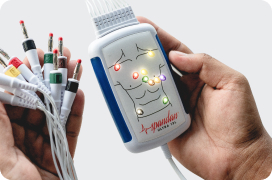
Author:- Mr. Ritesh Sharma
When you think of an electrocardiogram waveform pattern generated by an ECG machine, you normally think of P-wave, QRS complex, and T-wave. However, there is another wave that is under-discussed in the field of cardiac care, i.e. the U wave. Even if the U wave is not as widely discussed as the other ECG waveform patterns, it holds equal importance. The study of U wave in the domain of an electrocardiogram is deeply intricate. Peeling each of its facets is important for cardiologists and general people alike.
In this blog, we will explore the U wave in ECG in its entirety. We will delve into several aspects of it, including its significance, and what it can reveal about your cardiac health going beyond P-wave ECG abnormalities, QRS complex abnormalities, and T-wave abnormalities. So, whether you belong to the category of the general audience or clinicians, this blog will be an informative read for you.
Understanding the U Wave
The U wave is a small, positive deflection following the T wave on an abnormal ECG. It is not always visible, and its absence does not necessarily indicate a problem. The U wave represents the repolarization of the Purkinje fibers, which are part of the heart’s conduction system, or it could be due to the late repolarization of the mid-myocardial M cells. Although it is the least understood and least studied part of the ECG, it holds vital clues to cardiac health.
Characteristics of the U Wave
The U wave typically appears:
- After the T Wave: It follows the T wave and precedes the next P wave.
- Small and Positive: The U wave is generally smaller in amplitude compared to other waves and is usually positive in most leads.
- Best Seen in Leads V2 and V3: It is often best observed in the precordial leads, particularly V2 and V3.
Clinical Significance of the U Wave
While the U wave might seem insignificant due to its small size and occasional absence, it can be an indicator of several important clinical conditions:
- Electrolyte Imbalances:
- Hypokalemia: A prominent U wave is often associated with low potassium levels in the blood. Hypokalemia can lead to severe cardiac arrhythmias and requires prompt medical attention.
- Hypercalcemia: Elevated calcium levels can also affect the U wave.
- Cardiac Conditions:
- Bradycardia: Slow heart rates can make the U wave more pronounced.
- Left Ventricular Hypertrophy: Changes in the size and shape of the U wave can be seen in patients with left ventricular hypertrophy.
- Medications:
- Antiarrhythmic Drugs: Certain medications used to treat arrhythmias can influence the morphology of the U wave.
- Antiarrhythmic Drugs: Certain medications used to treat arrhythmias can influence the morphology of the U wave.
- Inherited Arrhythmias:
- Long QT Syndrome: This genetic condition can be associated with an abnormal U wave, leading to a prolonged QT interval and increasing the risk of sudden cardiac death.
Pathological U Waves
Pathological U waves can be larger than normal and may appear inverted in certain conditions. This abnormal waves can indicate underlying cardiac issues:
- Ischemic Heart Disease: Inverted U waves in specific leads can be a sign of myocardial ischemia.
- Intracranial Hemorrhage: Neurological conditions like subarachnoid hemorrhage can also cause changes in this wave.
Differentiating U Waves from Other Waves
Differentiating the U wave from other components of the ECG is crucial for accurate interpretation. The U wave should not be confused with:
- T Wave: The T wave represents ventricular repolarization and typically has a higher amplitude than the U wave.
- P Wave: The P wave precedes the QRS complex and indicates atrial depolarization.
Clinical Cases and Examples
Case 1: Hypokalemia
A 45-year-old patient presents with muscle weakness and fatigue. ECG shows prominent U waves in leads V2 and V3. Blood tests confirm low potassium levels. The patient is treated with potassium supplements, and follow-up ECG shows normalization of the U waves.
Case 2: Long QT Syndrome
A 25-year-old patient with a family history of sudden cardiac death undergoes routine ECG screening. The ECG reveals a prolonged QT interval and noticeable U waves. Genetic testing confirms Long QT Syndrome. The patient is managed with beta-blockers and advised to avoid strenuous activities.
This wave, though often overlooked, provides valuable insights into cardiac health. Its presence, shape, and size can indicate electrolyte imbalances, medication effects, and underlying cardiac conditions. Understanding and recognizing the significance of the U wave can aid in early diagnosis and management of potential cardiac issues.
Healthcare professionals should be vigilant in observing the U wave during ECG interpretation, as it holds the key to a deeper understanding of the patient’s cardiac status. For patients, awareness of the U wave’s importance can lead to proactive discussions with healthcare providers, ensuring comprehensive cardiac care.
In summary, the U wave in ECG is a small but mighty component, offering a window into the heart’s intricate electrical activities. By paying attention to this often-neglected wave, we can enhance our ability to diagnose and treat a range of cardiac conditions including cardiac arrhythmias and heart dysfunctions, ultimately improving patient outcomes and heart health.





